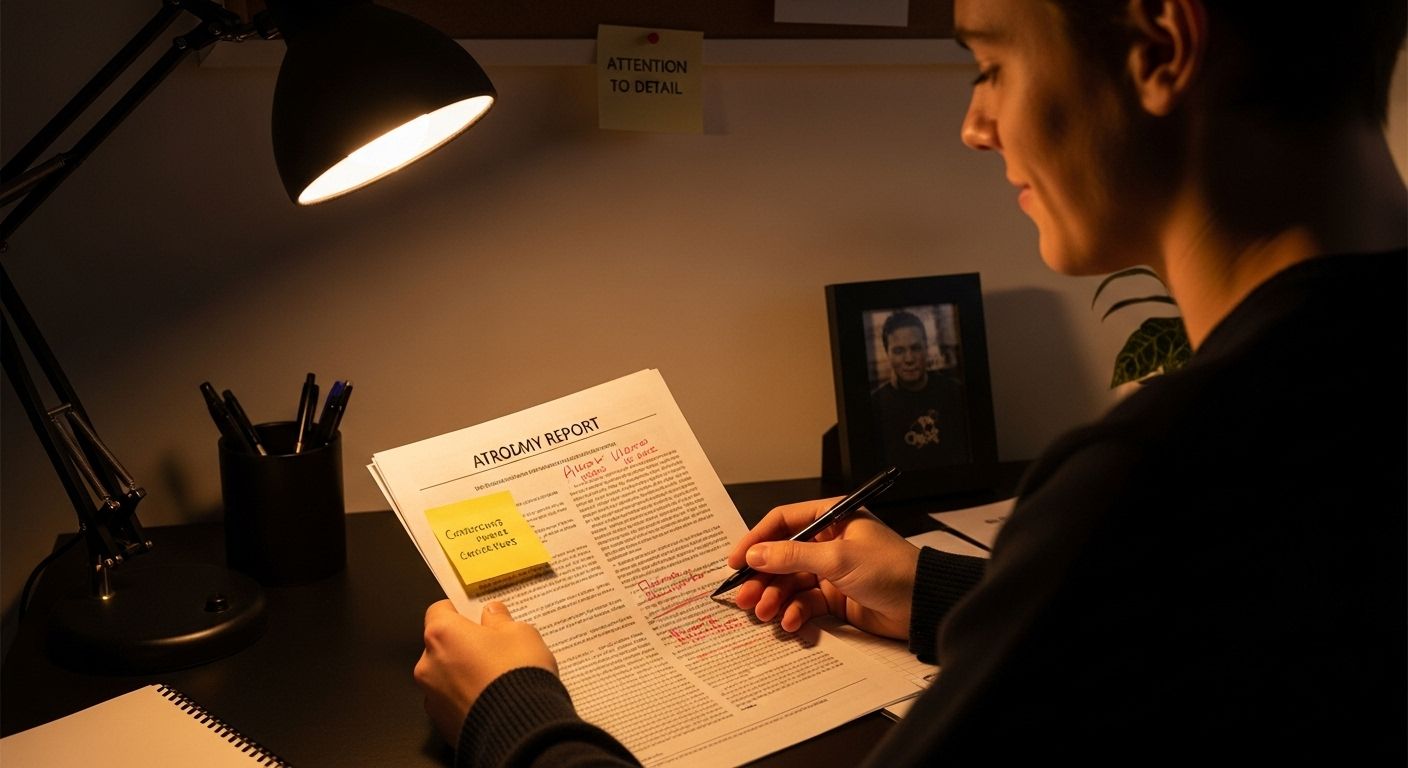
Proofreading sits at the very end of the writing process and most people see it as a quick fix for typos or missing commas. But that final review is where things can go from polished to disastrous in seconds. A single missing comma once led to a multimillion-dollar lawsuit due to legal ambiguity. Proofreading is about much more than good grammar. It can make the difference between clear communication and costly confusion.
Table of Contents
- What Is Proofreading And Its Primary Purpose?
- Why Does Proofreading Matter For Academic Success?
- How Proofreading Enhances Clarity And Impact Of Writing?
- What Are Common Mistakes Caught By Proofreading?
- Real-World Examples Of Proofreading’s Importance In Communication
Quick Summary
| Takeaway | Explanation |
|---|---|
| Proofreading is essential for clear communication. | Proofreading identifies and corrects errors that may confuse readers, ensuring that the core message is effectively conveyed. |
| Key elements include multiple reading strategies. | Techniques such as reading backward and varying focus help catch mistakes that might be overlooked in routine reviews. |
| Proofreading impacts academic success and credibility. | Well-proofed documents reflect attention to detail, enhancing a student’s perceived professionalism and potentially improving grades. |
| Common mistakes include grammatical and contextual errors. | Proofreading helps catch errors like subject-verb agreement issues and contextual ambiguities that can undermine clarity. |
| Mistakes can have serious real-world consequences. | Errors in professional documents can lead to significant legal, financial, or safety issues, emphasizing the need for precise communication. |
What is Proofreading and Its Primary Purpose?
Proofreading represents the final critical stage of writing where authors meticulously review their documents to identify and correct surface-level errors that could compromise communication quality. According to the UNC Writing Center, proofreading focuses specifically on catching minor mistakes that might distract readers from understanding the core message.
Understanding the Core Definition
At its essence, proofreading is a detailed examination of written content designed to eliminate grammatical, spelling, punctuation, formatting, and typographical errors. Unlike comprehensive editing, which addresses structural and content-level improvements, proofreading targets the document’s technical precision. Writers perform this process as the ultimate refinement step, ensuring their work appears polished, professional, and credible.
Key Elements of Effective Proofreading
Professional proofreading involves several strategic approaches to maximize error detection:
- Reviewing text multiple times with different focus areas
- Reading content backward to interrupt normal reading patterns
- Using digital and manual checking techniques
- Checking formatting consistency
- Verifying technical accuracy of references and citations
Why Does Proofreading Matter for Academic Success?
Proofreading is not merely a superficial exercise but a critical skill that directly impacts academic performance and professional credibility. According to ETS GRE Analytical Writing scoring descriptors, grammatical control and mechanical precision significantly influence assessment outcomes, underscoring the profound importance of meticulous document review.
Academic Evaluation and Credibility
In academic environments, written assignments serve as primary indicators of a student’s comprehension, analytical skills, and communication proficiency. Poorly proofread documents can dramatically undermine an otherwise excellent argument. Grammatical errors, typos, and formatting inconsistencies can distract evaluators, potentially reducing the perceived quality of the work and negatively impacting grades. Professors and academic reviewers consistently emphasize that technical precision reflects intellectual rigor and academic discipline.
Performance Impact Across Academic Domains
Proofreading’s significance extends across multiple academic contexts:
- Research paper submissions
- Scholarship and grant applications
- Thesis and dissertation documents
- Standardized test essays
- Academic competition entries
Each of these scenarios demands not just content excellence but also impeccable presentation. A single overlooked error can suggest carelessness, potentially compromising the document’s entire credibility.Moreover, strong proofreading skills prepare students for professional environments where communication precision is paramount.
How Proofreading Enhances Clarity and Impact of Writing?
Proofreading transcends simple error correction and serves as a strategic communication refinement process. According to research from the CDC’s Clear Communication Index, systematic review of writing mechanics directly influences message comprehension and reader engagement.
The Psychological Impact of Precision
Readers unconsciously evaluate written content through a lens of credibility and professionalism. Grammatical errors and typographical mistakes can significantly diminish the perceived quality of an argument, creating psychological barriers that prevent readers from fully engaging with the content. When documents appear polished and meticulously crafted, readers are more likely to trust the information and take the writer seriously.
Communication Effectiveness and Reader Trust
Proofreading impacts communication effectiveness through multiple critical dimensions:
- Eliminating distracting grammatical errors
- Ensuring logical sentence structure
- Maintaining consistent formatting
- Preserving the intended semantic meaning
- Demonstrating professional attention to detail
Ultimately, proofreading is an investment in clear, respected communication. By dedicating time to refining written work, writers transform potentially disjointed text into compelling, credible narratives that effectively convey complex ideas with precision and grace.

What Are Common Mistakes Caught by Proofreading?
Proofreading serves as a critical checkpoint for identifying subtle yet significant writing errors that can undermine communication effectiveness. According to the NIH’s Plain Language Guidelines, systematic document review helps catch multiple categories of mistakes that automated tools frequently miss.
Grammatical and Structural Errors
Grammatical mistakes represent the most common issues discovered during proofreading. These errors extend beyond simple spelling problems and include complex linguistic challenges that fundamentally alter sentence meaning. Writers frequently encounter challenges with:
- Subject-verb agreement inconsistencies
- Inappropriate pronoun references
- Sentence fragment construction
- Run-on sentence structures
- Incorrect verb tense usage
Contextual and Technical Mistakes
Beyond basic grammatical concerns, proofreading reveals nuanced errors that require deep contextual understanding. These include:
- Homophone mix-ups (their/there/they’re)
- Punctuation placement errors
- Formatting inconsistencies
- Unintentional word repetitions
- Semantic ambiguities
To help distinguish between different types of errors that proofreading typically catches, the following table breaks down common grammatical and contextual mistakes found during the proofreading process.
| Error Type | Examples | Impact on Communication |
|---|---|---|
| Grammatical | Subject-verb agreement, incorrect tense | Alters intended meaning, causes confusion |
| Punctuation | Missing commas, incorrect placement | Creates ambiguity, affects clarity |
| Spelling | Misspelled words (e.g., “definately”) | Reduces professionalism, distracts |
| Formatting | Inconsistent fonts, headings | Appears careless, disrupts flow |
| Typographical | Double words, omitted letters | Distracts readers, lowers trust |
| Contextual | Homophone errors (their/there) | Changes meaning, confuses reader |
| Structural | Fragments, run-ons | Weakens argument, decreases readability |

Real-World Examples of Proofreading’s Importance in Communication
Precise communication can have profound legal, financial, and safety implications. According to the Maine State Legislature’s Legal Amendment, even minor punctuation and wording errors can trigger significant legal consequences that require extensive correction.
Legal and Financial Consequences
Miscommunication through imprecise writing can result in multimillion-dollar legal disputes. The landmark O’Connor v. Oakhurst Dairy case demonstrated how a missing serial comma created ambiguity in an overtime pay statute, leading to prolonged litigation. This example illustrates that seemingly insignificant grammatical details can have substantial financial repercussions.
Safety-Critical Communication Scenarios
In high-stakes environments, proofreading errors can create dangerous situations:
- Pharmaceutical labeling mistakes
- Medical prescription documentation
- Product recall instructions
- Technical equipment manuals
- Emergency response communication
Beyond immediate risks, consistent proofreading establishes organizational credibility. Professionals who prioritize communication precision signal competence, attention to detail, and commitment to clear, responsible information sharing.
Struggling With Proofreading? Put Your Academic Writing in Safe Hands
Are you worried that small grammar errors or missed typos might lower your grades or weaken your credibility, just as discussed in this article about the real consequences of unchecked mistakes? Students often spend hours perfecting their ideas, only to struggle with catching those final, hidden errors that can distract professors or affect assessment outcomes. Quality proofreading can make or break your academic success and attention to detail shows you care about professionalism and clarity.
You do not have to face this challenge alone. At helpforhomework.com, our expert writers specialize in delivering papers that are not just well-researched and plagiarism-free, but also perfectly proofread and formatted. If you want to impress with academic excellence and confidence, order your custom essay or research paper now to make sure your work is error-free. The next step is simple: visit helpforhomework, tailor your order, and let our professionals handle the proofreading so your writing always stands out. Now is your chance to prevent costly mistakes and achieve the results you deserve.
Frequently Asked Questions
What is the purpose of proofreading in writing?
Proofreading serves as the final stage of writing, where authors review their documents to identify and correct surface-level errors such as grammatical, spelling, punctuation, and formatting mistakes, ensuring clear communication.
How does proofreading impact academic success?
Proofreading is essential for academic success as it helps eliminate errors that can distract evaluators from the core message. Meticulous proofreading reflects intellectual rigor and can significantly influence grading outcomes.
What common mistakes can be caught during proofreading?
Common mistakes identified during proofreading include grammatical errors, such as subject-verb agreement issues, punctuation errors, contextual mix-ups (like homophones), and formatting inconsistencies. These errors, if uncorrected, can lead to confusion and reduce the effectiveness of communication.
Why is proofreading important in professional communication?
In professional environments, proofreading ensures that written communication is clear and precise. Errors can undermine credibility and lead to costly misunderstandings, particularly in high-stakes situations like legal documents or medical instructions.
